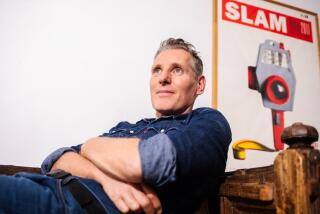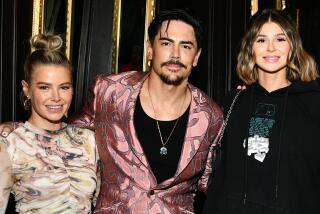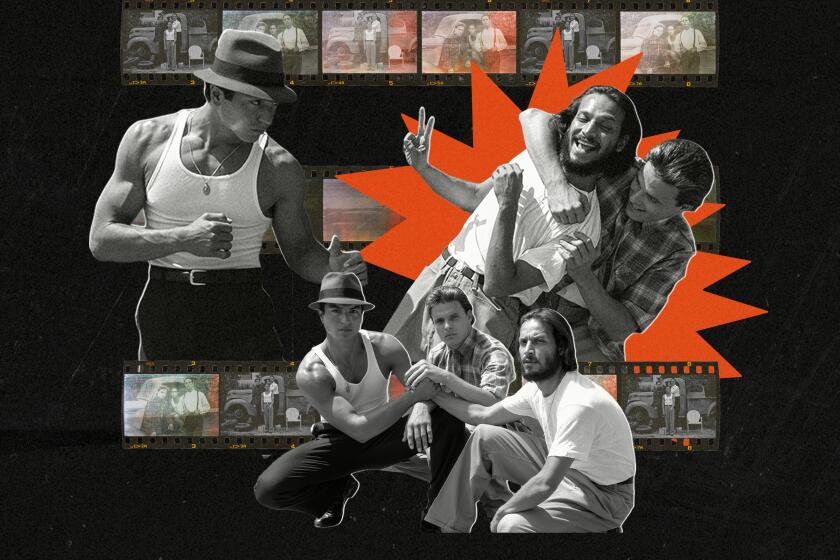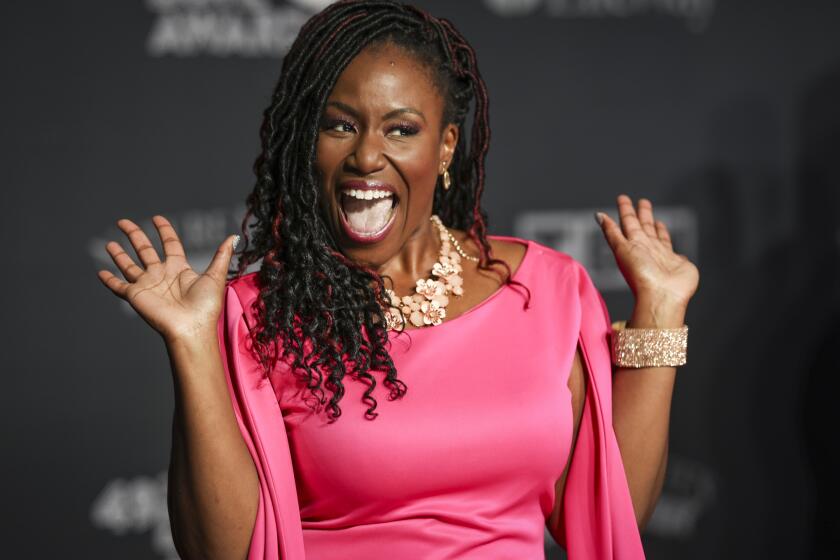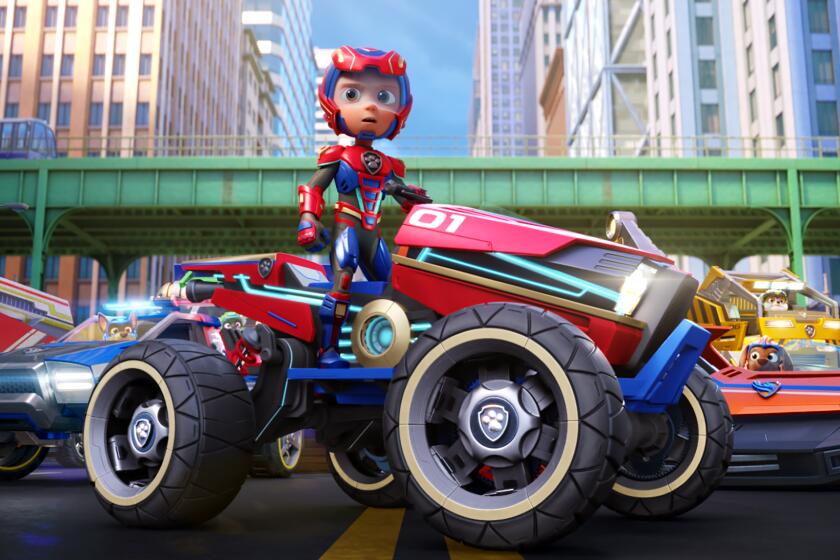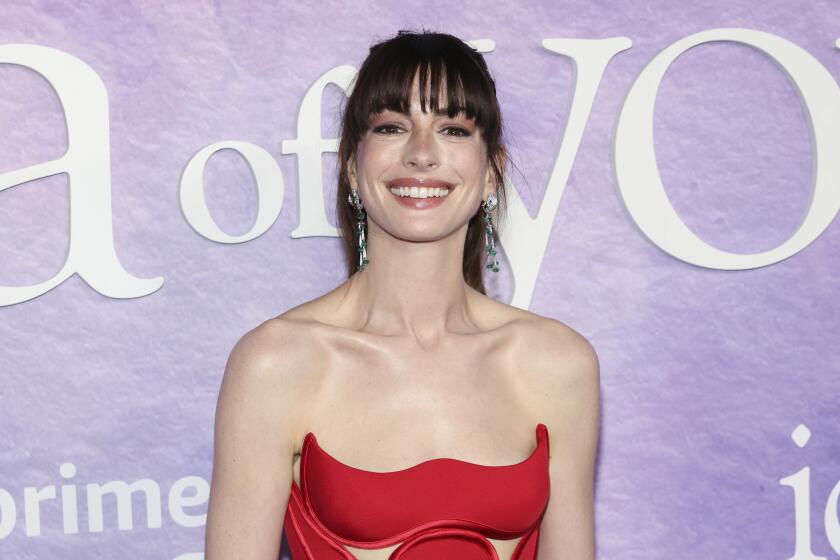Separated at Mirth : The comics biz is a man’s world. But these women are joining forces for the last laugh.
Leslie Sternbergh began her brilliant career drawing little naked ladies for the boys.
“They were so demure,” says the Brooklyn, N.Y.-based cartoonist. “They were little odalisques, naked maja things on a chaise lounge. I would draw them for the boys, and they would give me their lunch money and I would buy comics.”
From that auspicious start came a happily two-dimensional life modeling for artists and drawing for such underground publications as Wimmen’s Comix. And now, at the hallowed age of 35, Sternbergh has reached a zenith rarely scaled by women cartoonists. She’s infiltrating the pages of Mad magazine.
“I’m racking my brain trying to think if there has ever been a female art credit,” says Sternbergh, who peppers her speech with such balloon words as eek .
There have been only a few others, says Mad Assistant Editor Andrew Schwartzberg: “Mad started off as a boys’ club of some sort and it’s a male-oriented magazine.”
It’s enough to make the scarce woman cartoonist grumble, whether her bailiwick is mainstream comic books and strips or even the underground, rules-breaking cartoons born with a ‘60s sensibility and a home in alternative books and weeklies.
“There are very few fields as heavily male,” says Trina Robbins, author of “A Century of Women Cartoonists.” “Maybe the only equivalent is the fire department.”
Not everyone agrees, though, that it’s discrimination that thins their ranks. While cartoon journalist Heidi MacDonald says, “Men don’t think women can draw super-heroes, and I’ve been told that by male editors to my face,” several other female cartoonists say they’ve never felt slighted.
Still, their meager numbers give women cartoonists an identity headache. That is, they’re rarely simply called cartoonists--it’s usually women cartoonists.
“I was introduced by this feminist in San Francisco as a woman cartoonist,” sniffs Carol Lay, an L.A.-born cartoonist and recent New York transplant. “I was thinking, ‘Oh, it’s not self-evident what sex I am?’ ”
So, ahem, women cartoonists are ganging up to curry safety--and recognition--in numbers. Diane Noomin began lifting the veil of anonymity in 1991 by editing “Twisted Sisters: A Collection of Bad Girl Art,” a Penguin trade paperback anthology of the work of 14 alternative cartoonists. Robbins’ history was published by Kitchen Sink Press in 1993, and a second anthology--”Twisted Sisters 2: Drawing the Line”--is due out from Kitchen Sink in April, to be linked to an exhibition of the book’s original drawings at San Francisco’s Cartoon Art Museum in July.
“In general, women tend to be less visible, and that’s a reason I wanted to do this,” says Noomin, a San Francisco-based cartoonist. “I would be really thrilled if the words women cartoonist were never said again. They don’t say ‘men cartoonists.’ But given the fact that you have to say that, this is an in-your-face way for people to see there are a lot of good ones.”
Women are also launching their own professional organization, the Friends of Lulu, named after that Depression Era comics classic Little Lulu. The idea is to buck the male super-hero-dominated industry. Indeed, the more lucrative mainstream ranks have no more than 20 women writing and drawing amid hundreds of male counterparts--and that’s five times as many as there were 10 years ago, says Karen Berger, executive editor of the DC Comics imprint Vertigo, which is geared to a mixed audience.
“We’re trying to point out at the crassest level there’s money to be made (in publishing comics for women), and that opens it up for women cartoonists to have more opportunities,” says MacDonald, Lulu organizer and associate comics editor for Disney Adventures magazine.
*
Gloriosky! How did things get so lopsided?
Oddly, they didn’t start out that way. There were more women cartooning for major newspapers 50 years ago--10 in 1942 but only four in 1992, says historian Robbins.
And comics for girls were riding high in the ‘40s and through the early ‘60s, the heyday of teen heroines Millie the Model, Patsy Walker and Tessie the Typist.
But the “silver age of comics” that ruled the ‘60s tarnished the prospects for such teen fare, Robbins says. Super-heroes immortalized by the artist Roy Lichtenstein took off with the rise of pop art, which gave comics eclat among college students. And as super-heroes became hipper, other kinds of comics were eclipsed.
Meanwhile, distribution changes in the ‘70s wreaked havoc on the remaining teen title market. Comic books, which had been sold in such universal gathering spots as drug and candy stores, began hitting the shelves of the new comic book shops, now numbering about 5,000 nationwide. And since those stores tend to be owned by comic book collectors--mostly men--their titles skew toward men’s taste, Robbins says.
The resulting atmosphere is so female-user-unfriendly that even women in the field are intimidated. (In one notable exception, L.A.’s Golden Apple carries a wide swath of books that appeal to women as well as a variety of ethnic groups.) And now 90% to 95% of comics readers are male, MacDonald wrote in the catalogue for “Broad Humor,” a 1992 show of women cartoonists at the Cartoon Art Museum.
“Comic book stores are kind of creepy,” says Encinitas cartoonist Mary Fleener, 43. “There are all these kids, and there’s no women in there and no women over 30, for God’s sake. I feel like a total misfit and here I am drawing comics.”
DC’s Berger says funneling books to the comics stores aborted some of her efforts to launch mainstream titles for girls.
“The books didn’t do well and they were canceled,” she says.
The Twisted Sisters anthology was designed to leapfrog that obstacle by coming out as a paperback suitable for bookstores instead of comics stores, allowing women readers to discover it on familiar turf. And Twisted Sisters, which focuses on the underground, is a good primer on the work of women cartoonists because they tend to swim in alternative waters.
Twisted Sisters editor Noomin says she was never attracted to corporate comics mills such as Marvel and DC, which generally cater to male aesthetics even though DC’s CEO is a woman--Jeannette Kahn.
“Certainly the popular he-man, super-hero-type comics were never going to appeal to women,” Noomin says. “They are adolescent male sex fantasies about men saving bosomy women from snakes. Pretty Freudian stuff.”
*
What does appeal to women cartoonists is more personal work, often autobiographical, jibing nicely with a general trend in underground comics over the past decade. Instead of supernatural feats, they tackle intimate topics ranging from relationships, miscarriages and rape to surfing and having your ears blocked on an airplane.
Much of the work has a certain raw edge to it, and some of it is laced with anger honed by sharp wit.
Lay, who cherishes the artistic freedom the underground provides, plumbs her personal life for “a wealth of material.”
“I just think any relationship is enough to piss off anybody,” she says. “I just broke up with a boyfriend a few months ago, and I got 10 strips out of it so far.
“I didn’t run them in New York because this is where he lives, but somebody here saw them and said, ‘I think those are mean.’ I don’t see them as mean. I see them as cathartic and honest. I think men might see it as being mean because they might be afraid of women who express themselves honestly.”
Gender-driven debates go back to the birth of the cartoon underground in the ‘60s, when such comics classics as Robert Crumb’s Zap were publishing randy depictions of women. Such work has also touched off sharp debate among women cartoonists over the issue of political correctness.
Sternbergh, for one, says Zap’s excesses may have simply amounted to “a bunch of horny young guys on drugs having fun, realizing, ‘Hey, we can publish this stuff!’ It was the ‘60s, for heaven’s sake.”
Robbins, a pioneering cartoonist in underground comics headquarters, San Francisco, spearheaded a feminist volley against the Zap view of the world in the early ‘70s.
“I think a lot of comics by males in the underground have definitely degraded women,” she says. “They’re very hostile--not all of them, but a lot. In the underground, where you’re free to express yourself, a lot of men consider this their opportunity.”
Robbins also considered it hers, and in 1970, she put together one of the first underground women’s comic books, “It Ain’t Me, Babe.” That was followed two years later with Wimmen’s Comix, created by a women’s collective, which published irregularly for the next 20 years.
*
Another early ‘70s reaction to the male underground’s take on women was the controversial work of two Southern Californians, Joyce Farmer and Lynn Chevely, who published under the pseudonym Chin Lyvely. Their book dealt with women’s sexuality and it boasted a provocative title that played off slang for women’s private parts.
“Of course, women and sexuality involves having periods and other things, and we included the other things,” Farmer says. “We used menstrual blood and joked about it, which was a no-no.”
Their title nearly became part of an anti-pornography bust of a Laguna Beach bookstore, Fahrenheit 451, in 1973. An investigator from the Orange County marshal’s office bought a copy along with issues of Zap and other underground comics. When marshals returned to raid the store and arrest the bookstore owners on obscenity charges, the women’s title wasn’t included because no copies were left. The case was ultimately dropped.
“If they were successful in the comic books (bust) at the sale point, they would be able to go after the publishers, and all we were were two women doing their thing,” Farmer says. “It scared the total bejesus out of us. . . . And it turned out bookstore owners were more and more unwilling to carry underground comics. For a 50-cent item, they could get themselves into a heap of trouble, and it would be expensive to deal with.”
By the mid-’70s, underground women cartoonists were tussling among themselves. Noomin and Aline Kominsky-Crumb, Crumb’s wife, reacted against what they viewed as the politically sterile terrain of the Wimmen’s Comix Collective by creating the first freewheeling issues of Twisted Sisters, the forerunner of the anthology 15 years later.
In Wimmen’s Comix, “women were to be more glorified and idealized and we were doing more self-deprecating and ironic humor,” says Noomin, whose husband, alternative cartoonist Bill Griffith, draws Zippy the Pinhead.
Gender issues have also complicated careers for the rare women drawing newspaper cartoon strips. Nicole Hollander launched “Sylvia” in 1980 via a newspaper syndicate, but only a dozen papers picked it up.
“My experience was it was men selling to men,” she says. “It was all male salesmen and the features editors were men. I didn’t feel anyone understood what I was doing.”
Hollander self-syndicated “Sylvia” at the end of 1981, and the strip is now carried in about 70 newspapers, including The Times.
The good news for women cartoonists is that such resourcefulness--and the recent move into books and exhibitions--is boosting their visibility, which in turn encourages others.
“There’s a boom of women doing it now,” says L.A. underground cartoonist Krystyne Kryttre. “They see other women doing it and go, ‘Wow, that’s neat!’ ”
And their future could be bright, cartoonists say, if publishers tap the unmined market of women comics readers.
“I not only think the market’s there, I think it’s huge,” says Cathy Guisewite, noting the popularity of her strip, “Cathy,” which is carried by 1,200 newspapers.
“And while it was difficult to sell at first, I think my strip succeeded because it had it’s unique point of view and it wasn’t trying to appeal to everyone all the time. I think there’s always going to be room for that.”
More to Read
The biggest entertainment stories
Get our big stories about Hollywood, film, television, music, arts, culture and more right in your inbox as soon as they publish.
You may occasionally receive promotional content from the Los Angeles Times.
